An inflow control device completion method used to perform horizontal hole segmentation enhances uniform production.
Salem El-Abd, Abdel Hameed Amiri, Ashraf Keshka, Salem Al-Bakr, Saif Al Arfi, ADCO; Magdi El-Asmar, Baker Oil Tools
Horizontal-well technology provides established methods of drilling conventional wells to improve reservoir contact and drainage and to delay the production of undesirable fluids. However, non-uniform production profiles, especially in highly heterogeneous and fractured reservoirs, can result in premature water production, causing bypassed oil and lower ultimate recovery and, therefore, a decrease in profitability.
Shortened well life is directly linked to water production. When water moves toward a wellbore, sweep efficiency is impacted. The well must be worked over or new wells must be drilled to sustain the field’s production capacity. Improved completion systems must become part of the production strategy.
In a producing field operated by ADCO in the United Arab Emirates, a new completion technology has been installed for the first time to address this issue. Horizontal hole segmentation using the Inflow Control Device (ICD) completion method has been tested as a pilot program in one new and one existing well, both located in highly fractured areas.
FRACTURE SWARMS
At the early stage of the field development, the significance of fractures in this reservoir was not recognized. However, the latest fracture study integrates all available seismic and production data to reveal that the reservoir contains a complex fracture network within the highly heterogeneous matrix system. Both matrix and fracture systems play an important role in the production mechanism of the reservoir.
The reservoir is characterized by the presence of sucrosic dolomite rock that significantly enhances matrix permeability. The matrix permeability ranges from 0.01 mD to 12 D with the average in excess of 100 mD. The fractures are described as a fracture corridor system, or fracture swarms, of sub-seismic faults that may extend laterally for hundreds of meters and sometimes over several kilometers. The pay zone formation is a complex fractured carbonate reservoir exhibiting considerable lateral and vertical lithological changes. The fracture swarm zones, ranging from 50 to 100 m, are oriented in two main directions: N40°E and N70°E, Fig. 1. No diffuse fracturing can be characterized, meaning that this reservoir is weakly fractured between the fracture swarm zones.
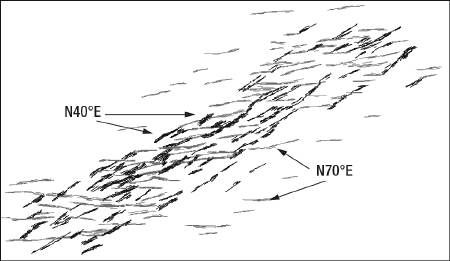 |
|
Fig. 1. Fracture maps showing the two main directions (N40°E and N70°E).
|
|
BUSINESS CASE
A multidisciplinary team was formed to investigate an economical solution to the problem of the non-uniform production profile and water progress across the horizontal sections. Production Logging Tool (PLT) surveys were carried out in openhole horizontal wells to define the produced-water entry points and measure the base sigma log for saturation monitoring.
Well A was located in a highly fractured area, Fig. 2. The results of the PLT survey indicated a non-uniform production profile across the horizontal section, and most of the oil- and water-producing intervals were in line with the fracture study, Fig. 3. When the watercut reached 50% in this well, horizontal drilling was planned in another direction, but after the completion was retrieved, the casing corrosion log indicated that the casing was severely corroded. Therefore, the well was plugged and abandoned and a replacement well was drilled.
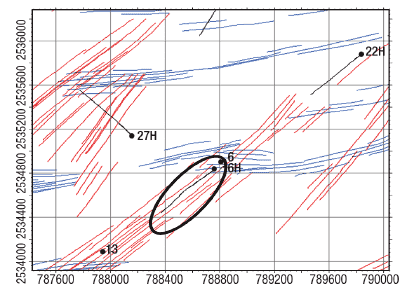 |
|
Fig. 2. Location of Well A on the fracture map.
|
|
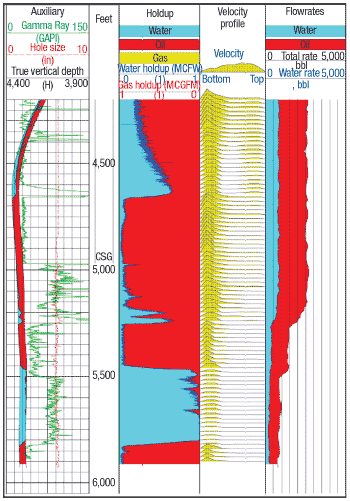 |
|
Fig. 3. PLT results of Well A.
|
|
A PLT survey of Well B (Fig. 4) indicated that a short interval of about 40 ft was contributing 70% of the total oil production and some 80% of the water production tests revealed that the high oil and water production rates from this short interval and the sharp increase in temperature were due to the presence of large fractures. Although Well C was located in an area considered homogeneous, PLT results indicated that the first half of the horizontal section was contributing all of the production and the second half of the hole was contributing nothing.
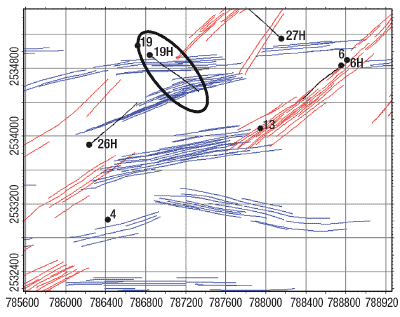 |
|
Fig. 4. Location of Well B on the fracture map.
|
|
All of the wells were found to have non-uniform production profiles. Based on these results, the need for a completion technique to achieve uniform production profiles across the horizontal holes was raised, with the aim to improve the reservoir sweep efficiency by controlling the rate of watercut development and consequently increasing ultimate recovery.
TECHNO-ECONOMIC ASSESSMENT
Mechanical and chemical water shut-off techniques were investigated, but both techniques were found to be inefficient in the highly fractured reservoirs. Service companies offered three different technologies with similar functionalities to provide uniform production profiles. The technique of controlling the flow and establishing uniform production by allowing low- and high-permeability intervals to contribute to flow was found to be the optimum option for this highly fractured reservoir. After assessing risk, studying case histories and evaluating success ratios, the ICD system was found to be the optimum method to be tested as a pilot in a new well, Well D. This new well was drilled in a highly fractured area, especially the second half of the horizontal section, Fig. 5.
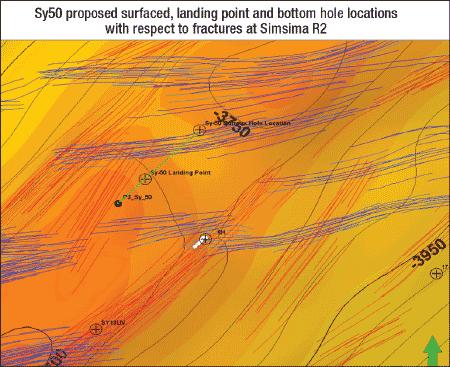 |
|
Fig. 5. Planned location of Well D.
|
|
Reservoir simulation runs evaluated the benefits of installing the ICD system in the new well. The results indicated that incremental production of 1.4 million bbl over the well’s life could be achieved by running the ICD system rather than a barefoot completion. Moreover, to evaluate the impact of installing the system on field-scale implementation, it was assumed that the system would be installed in 70% of the planned future wells that were expected to penetrate fractures. The results indicated that an incremental oil recovery of some 36 million bbl could be achieved. Simulation runs determined the number of ICDs required to achieve a uniform production profile.
ADCO carried out a detailed economic analysis of the production forecasts. The ICD case was compared to the barefoot completion case on a single well model with the following incremental economic indicators: Net Present Value (NPV), Unit Technical Cost (UTC) and Profit Investment Ratio (PIR):
- NPV @ 8% discount rate: $1.9 million
- UTC @ 8% discount rate: $4.4/bbl
- PIR @ 8% discount rate: 4.0%
- Incremental oil: 1.4 million bbl.
In its full field development plan, ADCO assumed that ICD systems would be installed in at least 70% of the planned future wells. Economic calculations indicated:
- NPV @ 8% discount rate: $43.9 million
- UTC @ 8% discount rate: $2.9/bbl
- PIR @ 8% discount rate: 6.7%
- Incremental oil: 36.3 million bbl.
OPERATIONAL FEASIBILITY
The multidisciplinary team ran an image log in Well D prior to the ICD completion to help define the required number and locations of ICDs and mechanical packers to achieve uniform production profile and control water progress. Based on the reservoir-model permeability profile, the original design was to run 10 ICDs and nine isolation packers, with the option to reduce the number as deemed necessary.
The function of the isolation packers was to compartmentalize the well without cement and further enhance the uniform production profile. Isolation packers were selected rather than swellable alternatives because borehole gauge variations in the carbonate reservoir could be beyond those packers’ swelling range, thus jeopardizing the seal.
Testing procedures and risk mitigations were discussed to ensure that proper implementation and safety precautions were met in accordance with industry standards.
IMPLEMENTATION AND EVALUATION
Well D was drilled and completed as a single lateral oil producer with a 2,000-ft horizontal hole. A total of 11 ICDs with 11 proprietary isolation packers were installed in the horizontal section with the aim to achieve a uniform production profile along the horizontal section and reduce water production. The well was completed with a 3.5-in. single completion string equipped with an Electric Submersible Pump (ESP) and Y-tool. When the well was tied in to the production station, the initial testing results indicated that the well produced about 2,100 bpd of dry oil. A PLT survey confirmed the reliability of the technique in achieving a uniform production profile across the horizontal section, Fig. 6.
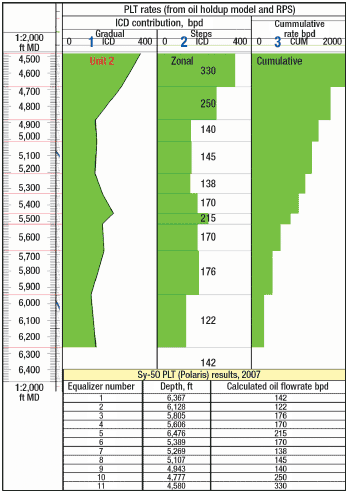 |
|
Fig. 6. PLT results of Well D.
|
|
In April 2007, the nine-year-old ESP failed in Well B due to a short circuit in the downhole string. In May 2007, the well was worked over to replace the ESP. Simulation runs were performed to determine the optimum number of ICDs and isolation packers to be installed. Based upon these runs, 11 ICDs and five isolation packers were recommended to be installed to achieve a better production profile. The well was tied in and produced some 2,500 bpd with traces of watercut, compared to about 7% watercut before workover. A PLT survey was carried out with two different production rates (2,000 and 3,000 bpd) to evaluate the impact of the ICD on the well performance in case of high production rates. The PLT interpretation (Fig. 7) indicated a uniform production profile across the horizontal hole with ICD completion when compared with the barefoot completion carried out in 2002. Both wells (B and D) are considered economically successful and will recover the targeted oil reserves.
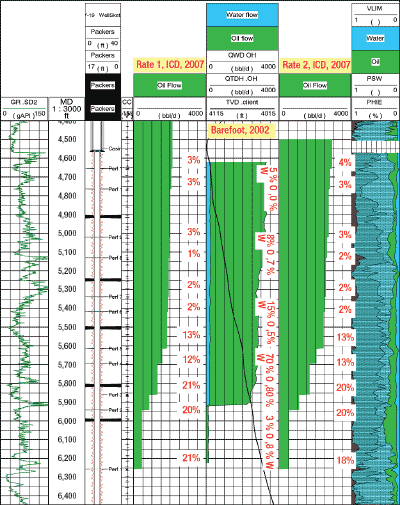 |
|
Fig. 7. Well B PLT results before and after ICD installation.
|
|
FULL FIELD DEVELOPMENT
The field-scale implementation plan is driven by optimizing ultimate recovery while maintaining/developing sustainable production capacity throughout longer production plateau length. A comprehensive techno-economical field development plan covering the optimum development scheme considered the application of ICDs as part of enhancing production efficiency. Different development options were studied along with the impact of ICD on sweep efficiency and in-fill drilling program.
ICD systems improve field economics by optimizing ultimate recovery, and they can assist in optimizing future development drilling and workover programs. These jobs were the first application of this technique in United Arab Emirates. ADCO and Baker Oil Tools expect that when ICD completions are installed in about 35 future wells, ultimate field recovery will be improved by an estimated 36 million bbl. 
|









